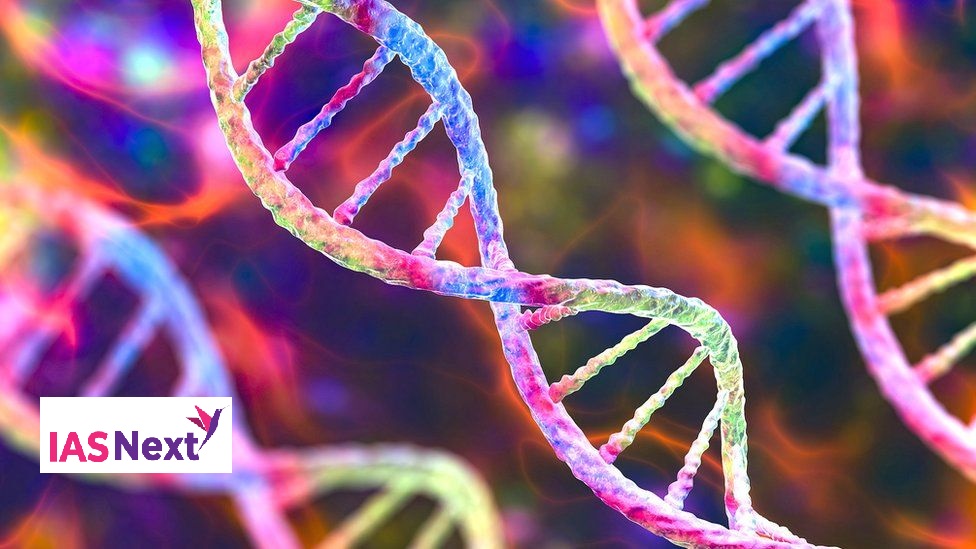CURRENT AFFAIRS
Get the most updated and recent current affair content on Padhaikaro.com
What is Genome sequencing?
- IAS NEXT, Lucknow
- 05, Apr 2022

Reference News :-
Complete human genome sequencing has been done Nearly two decades ago, when scientists published the map of the human genome for the first time, about 8% of the human DNA was left unsequenced. Now, this has been completed giving the picture of the human genome for the first time.
Why it matters
A complete human genome makes it easier to study genetic variation between individuals or between populations.
What was missing
- The genetic sequence made available in 2003 from the Human Genome Project, an international collaboration between 1990 and 2003, contained information from a region of the human genome known as the Here, the chromosome is rich in genes, and the DNA encodes for protein.
- The 8% that was left out was in the area called heterochromatin. This is a smaller portion of the genome, and does not produce protein.
- There were at least two key reasons why heterochromatin was given lower priority. This part of the genome was thought to be “junk DNA”, because it had no clear function. Besides, the euchromatin contained more genes that were simpler to sequence with the tools available at the time.
- Now, the fully sequenced genome is the result of the efforts of a global collaboration called the Telomere-2-Telomere (T2T) project. The invention of new methods of DNA sequencing and computational analysis helped complete the reading of the remaining 8% of the genome.
Genome sequencing is the process that involves deciphering the exact order of base pairs in an individual. This “deciphering” or reading of the genome is what sequencing is all about. Costs of sequencing differ based on the methods employed to do the reading or the accuracy stressed upon in decoding the genome.
Need for genome sequencing:
- Ever since the human genome was first sequenced in 2003, it
opened a fresh perspective on the link between disease and the unique genetic make-up of each individual.
- Nearly 10,000 diseases — including cystic fibrosis, thalassemia — are known to be the result of a single gene malfunctioning.
- While genes may render some insensitive to certain drugs, genome sequencing has shown that cancer too can be understood from the viewpoint of genetics, rather than being seen as a disease of certain organs
Importance of Genome Sequencing:
- A genetic test, which is commercially available at several outlets in the country, usually involves analysing only a portion of the genome that’s known to contain aberrant genes linked to disease.
- It is important to ensure that India, with its unparalleled human diversity, is adequately represented in terms of genomic data and develops indigenous capacity to generate, maintain, analyse, utilize and communicate large-scale genome data, in a scalable manner.
- Ever since the human genome was first sequenced in 2003, it opened a fresh perspective on the link between disease and the unique genetic make-up of each individual.
- Nearly 10,000 diseases including cystic fibrosis, thalassemia are known to be the result of a single gene malfunctioning.
- While genes may render some insensitive to certain drugs, genome sequencing has shown that cancer too can be understood from the viewpoint of genetics, rather than being seen as a disease of certain organs.
- The human genome has about 3.2 billion base pairs and just 10 years ago cost about $10,000. Now prices have fallen to a tenth.
India’s efforts towards Genome sequencing:
- Centre for Scientific and Industrial Research (CSIR) have done the whole genome sequencing of novel coronavirus
- IndiGen Genome project:
- The IndiGen initiative was undertaken by CSIR in April 2019, which was implemented by the CSIR-Institute of Genomics and Integrative Biology (IGIB), Delhi and CSIR-Centre for Cellular and Molecular Biology (CCMB), Hyderabad.
- The objective is to enable genetic epidemiology and develop public health technologies applications using population genome data.
- This has enabled benchmarking the scalability of genome sequencing and computational analysis at population scale in a defined timeline.
- The ability to decode the genetic blueprint of humans through whole genome sequencing will be a major driver for biomedical science.
- IndiGen programme aims to undertake whole genome sequencing of thousands of individuals representing diverse ethnic groups from India.
- Genome India:
- The Government of India has cleared a gene-mapping project called “Genome India” recently.
- To build a grid of the Indian “reference genome”, to understand fully the type and nature of diseases and traits that comprise the diverse Indian population.
- This is spearheaded by the Centre for Brain Research at Bengaluru-based Indian Institute of Science as the nodal point of about 20 institutions.